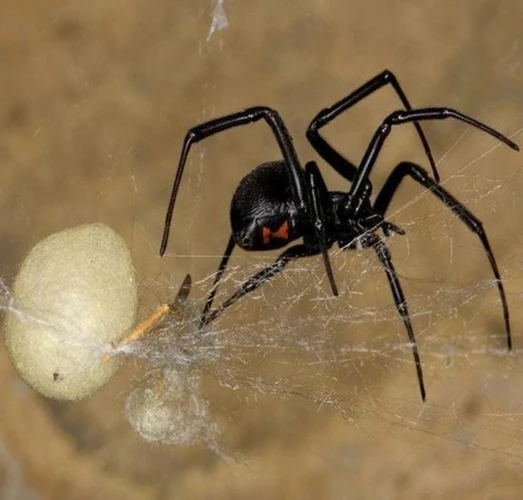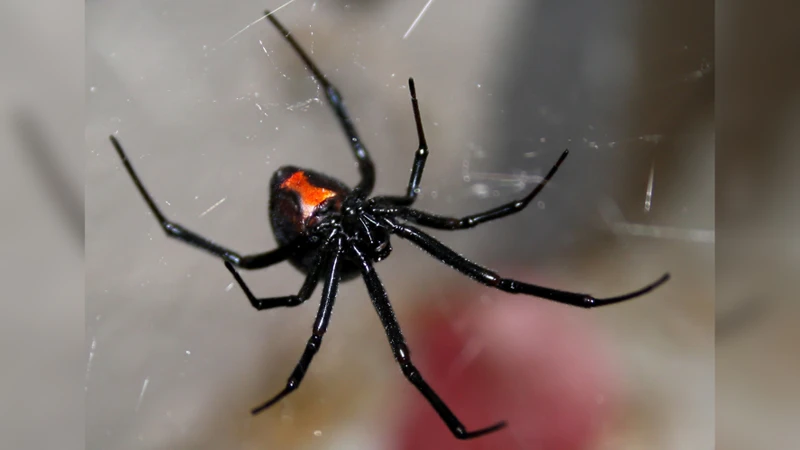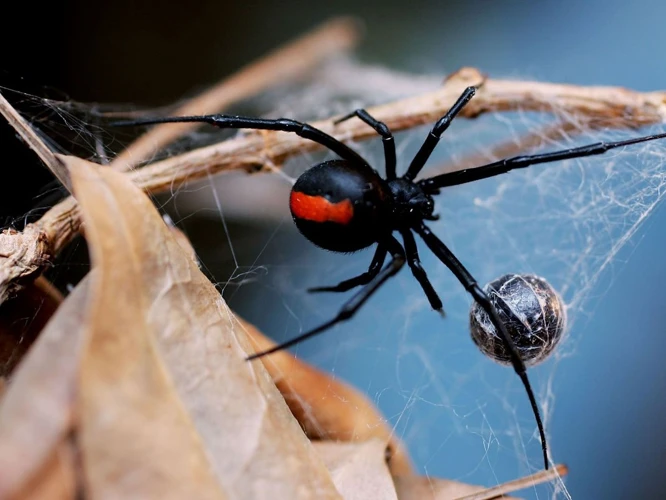As arachnophobes tremble at the mere mention of its name, it’s no secret that the black widow spider is considered one of the most notorious predatory insects in the world. However, the world of these creatures is full of mysteries and curious phenomena that intrigue researchers and the layman alike. One of the most common questions about these creatures is when do they achieve sexual maturity. This article explores the different factors that influence the onset of sexual maturity in black widow spiders and how to identify a mature specimen. So let’s spin the web and unravel the mystery behind the age at which black widow spiders become sexually mature.
What is Sexual Maturity?

Understanding the maturation process in Black Widow Spiders is crucial to their management and survival. Sexual maturity is an essential part of spider growth and reproduction, and it varies across different species. A spider that has reached sexual maturity is able to reproduce and pass on its genes to its offspring, ensuring the survival of its species. Achieving sexual maturity is a delicate balance of environmental and genetic factors, including temperature, humidity, and diet. In this article, we will dive deeper into the maturation process of Black Widow Spiders, exploring the various factors that affect their sexual maturity, and age at which they reach maturity, and how to identify them.
Defining Sexual Maturity
Defining Sexual Maturity
Sexual maturity is a critical stage in the life cycle of any organism, including the black widow spider. It is the point at which an individual reaches sexual maturity and is capable of breeding. In the case of black widow spiders, sexual maturity is defined as the stage at which the spiders are capable of producing viable sperm or eggs and mate successfully. This stage marks the beginning of the adult phase of the black widow spider’s life cycle.
The timing of sexual maturity varies between individuals and is influenced by many factors, including environmental conditions, diet, genetics, and overall health. Black widow spiders, like many other species, have a specific set of conditions that must be met for sexual maturity to occur. These conditions include optimal temperature and humidity levels, adequate food availability, and appropriate light and photoperiod.
Research has shown that the maturation process of black widow spiders varies depending on population density, mortality rate, and inter-species comparisons. For example, a comparative study conducted on male and female black widow spiders revealed significant differences in maturation rate, highlighting the importance of understanding the sexual maturity of both genders.
Understanding the maturation pattern and rate of black widow spiders is essential for effective management strategies. It is crucial to note that black widow spider maturation can increase the risk of human contact and bites, and the threshold mortality rate is an essential consideration in developing appropriate control measures.
In the upcoming sections, we will explore in detail the various factors that affect the sexual maturity of black widow spiders, including temperature and humidity, food availability and diet, light and photoperiod, genetics and species, and age at sexual maturity in both male and female black widow spiders.
Factors Affecting Sexual Maturity in Black Widow Spiders

It is important to understand the various factors that contribute to the sexual maturity of black widow spiders. A combination of environmental conditions, genetic makeup and dietary factors can all come into play. By analyzing the impact that different factors can have, it becomes possible to gain a more comprehensive understanding of the maturation process in black widow spider management. Let’s explore these factors that affect the sexual maturity of black widow spiders.
Temperature and Humidity
Temperature and humidity are crucial factors affecting the maturation process of black widow spiders. Black widow spiders thrive in warm and humid conditions, which contribute to the development of their reproductive system. The optimal temperature range for the black widow spider’s maturation process is between 70°F and 90°F (21°C and 32°C), with humidity levels ranging from 70% to 80%.
High temperatures speed up the maturation process of black widow spiders and enable them to reach sexual maturity faster. Conversely, cold temperatures slow down the process and can even cause death. On the other hand, high humidity levels provide the necessary moisture for the spiders to molt properly and develop their exoskeleton, while low humidity can lead to desiccation and death.
A study conducted by environmental conditions and maturation of black widow spiders found that high population density and low ventilation in breeding grounds can create an environment with higher temperature and humidity levels, contributing to the faster maturation process of black widow spiders. This study emphasizes the need for proper management of black widow spider populations to avoid high-density breeding grounds that could ultimately put humans at risk.
Temperature and humidity are extremely important factors affecting the maturation process of black widow spiders, and it is crucial to maintain optimal conditions for their growth and development.
Food Availability and Diet
The diet of a black widow spider plays a significant role in its maturation process. Black widows typically require a diet high in protein, which they obtain by consuming other insects, spiders, and even small lizards. The availability and diversity of food sources can impact the black widow spider’s growth and development.
Studies have shown that black widows who have access to a more diverse diet tend to mature more quickly and produce more offspring. A diet high in protein can contribute to the black widow’s growth rate, allowing it to reach sexual maturity faster. On the other hand, restricting food availability can delay the maturation process, affecting the overall population density of black widows in the area.
While diet is an important factor in the maturation process of black widow spiders, it is not the only variable at play. Temperature, humidity, and light exposure also have an impact on when these spiders reach sexual maturity. Genetics and the species of the black widow spider can also play a role.
To learn more about the maturation process of black widow spiders and how to manage their populations, check out our article on maturation process in black widow spider management.
Light and Photoperiod
Light and Photoperiod
Light and photoperiod are other factors that can impact black widow spiders’ sexual maturity. Photoperiod refers to the length of light each day, and it can vary based on location and seasonal changes. Specific changes in light exposure can also trigger hormonal changes in black widow spiders that can affect their reproductive rate.
Research has shown that threshold mortality rates for black widow spiders may vary depending on the amount of light exposure they receive, which can impact their overall survival rates and thus the timing of their sexual maturity.
In addition to the amount of light received, the type of light can also have an effect. Black widow spiders respond differently to different types of light, and some studies have shown that they prefer certain wavelengths of light for web building and mating.
The complex relationships between light exposure and hormonal changes in black widow spiders can impact their development and timing of sexual maturity in significant ways. It is important to note that there is still much to learn about these relationships and how they may vary across different populations and species of black widow spiders.
Genetics and Species
Genetics and Species: Genetics and species are important factors that determine when a black widow spider reaches sexual maturity. Different species of black widow spiders have different maturation rates, with some species reaching maturity faster than others. For example, the southern black widow spider (Latrodectus mactans) matures more quickly than the western black widow spider (Latrodectus hesperus).
Genetics play a role in maturation rates as well. Some individual spiders may mature more quickly or slowly than others based on their genetic makeup. This can be seen within populations as well, where certain genetic traits may be more prevalent and affect maturation rates.
A comparative study of male and female black widow spiders found that males tend to mature faster than females, which could be due to genetic factors or selective pressures. Additionally, inter-species comparison studies have shown that populations with higher density tend to mature more slowly, suggesting that competition for resources may play a role in maturation rates.
Genetics and species are important factors that influence when a black widow spider reaches sexual maturity. Different species have different maturation rates, while genetics can also play a role in determining how quickly individual spiders reach maturity. These factors should be taken into consideration when studying black widow spider biology.
Age at Sexual Maturity in Black Widow Spiders

It is a natural phenomenon for animals to enter the stage of sexual maturity, and black widow spiders are no exception. The age at which these spiders become sexually mature can vary depending on several factors such as temperature, humidity, availability of food, and genetics. Understanding the age of sexual maturity in black widow spiders is crucial for conservation efforts and better control of their population. In this section, we will delve into the age at which black widow spiders achieve sexual maturity, including a comparative study between male and female black widow spiders. We will also explore the maturation rate of these spiders, which is influenced by various factors. So, let’s explore this fascinating aspect of black widow spider biology.
Female Black Widow Spiders
Female black widow spiders reach sexual maturity at around three to four months of age. The timing of sexual maturity is heavily influenced by various factors such as temperature, humidity, and food availability. In areas with favorable conditions, female black widows may reach maturity closer to three months, while those in less favorable conditions may take up to six months or more to mature.
Factors influencing female black widow spider maturation
- Temperature: Warm temperatures can accelerate development and promote earlier maturation in female black widow spiders.
- Humidity: Adequate humidity levels are also essential for proper growth and development in female black widows. High levels of humidity can help speed up the molting process, which is necessary for sexual maturation.
- Food availability and diet: A consistent source of food is crucial for black widow spiders to reach maturity. Females that are well-fed and receive a nutrient-rich diet develop faster and reach maturity earlier than those that lack sufficient food.
- Light and photoperiod: The duration of sunlight and the amount of light a female black widow spider receives plays a significant role in its development. In areas with extended daylight hours, females may reach maturity earlier than in areas with shorter hours of daylight.
- Genetics and species: Some black widow spider species may have a shorter maturation period compared to other species due to genetic differences and variations in their life cycle.
Once female black widow spiders reach sexual maturity, they are capable of reproducing and can lay up to four or five egg sacs throughout their lifespan, with each sac containing around 250 eggs. The spiders’ population density can significantly affect their maturation rate, as high population densities may delay the maturation process. However, despite the risks associated with late maturation and reproduction, such as increased predation risk, females tend to prioritize growth and development over reproduction.
For more information on black widow spider maturation and population density, check our article on maturation rate and population density in black widow spiders.
Male Black Widow Spiders
Male black widow spiders undergo a different maturation process than their female counterparts. While females can live up to three years, males have a much shorter lifespan of only a few months, and their maturation rate is much quicker, due to sexual selection pressures. Male black widow spiders usually reach sexual maturity within 2-3 months after hatching.
Interestingly, male black widow spiders mature faster when they perceive a greater risk of mortality. A study found that when exposed to a predator’s chemical cues, male black widows matured faster than those kept in a predator-free environment. This phenomenon is an adaptation to ensure that male black widows can mate before they succumb to predation. Male black widows living in higher-density populations mature faster than those living alone, suggesting that population density cues may also play a role in their maturation rate.
Male black widow spiders mature more quickly due to the shortened lifespan that comes with their sex, but their maturation rate can be influenced by factors such as exposure to predators and population density cues. It’s important to remember that male black widow spiders can still be dangerous even before reaching sexual maturity, and should be approached with caution.
Identifying a Mature Black Widow Spider
Identifying a mature black widow spider is important to understand the behavior and characteristics of a sexually mature female. Female black widow spiders are larger than males, measuring up to 1.5 inches in body length, with a round and glossy black appearance. Mature females have a distinct hourglass-shaped marking on their abdomen, usually red or orange in color. On the other hand, males are smaller, about half the size of female black widows, with a brownish-gray coloration and spotted markings on their wings.
In addition to the physical appearance, mature black widow spiders also show characteristic behaviors. They tend to weave thick, tangled webs in shady areas or near holes in the ground where prey is likely to be found. They also become more aggressive and defensive towards perceived threats, especially when guarding their egg sacs.
It is important to emphasize that black widow spiders should be identified from a safe distance or by a trained professional, as their venom can be extremely dangerous. The venom of a black widow spider contains neurotoxins that can cause severe pain, muscle spasms, and even death in some cases.
Understanding and identifying the signs of a mature black widow spider can help individuals avoid potential risks and appreciate the fascinating life cycle of these remarkable creatures. To learn more about black widow spider maturation and behavior, check out our article on black widow spider maturity or a comparative study on maturation rates of male and female black widow spiders.
Conclusion
In conclusion, understanding the sexual maturity of black widow spiders is crucial in studying their reproductive behavior. It helps us identify the right time for mating and avoiding the risks associated with early or delayed maturation.
As we have seen, factors such as temperature, humidity, food, light, photoperiod, genetics, and species all play a role in determining when a black widow spider reaches sexual maturity. The age at which males and females mature differs, with females taking longer to mature due to practical reasons such as the need for larger size and energy reserves to bear offspring.
Identifying a mature black widow spider can be essential for keeping ourselves and our families safe, as these spiders can pose a significant threat if disturbed. Knowing the physical and behavioral traits associated with mature black widows can make all the difference in avoiding bites and minimizing health risks.
In conclusion, while there is still much to learn about the maturation rate of black widow spiders, we can gather useful information from existing studies. By understanding the factors involved in sexual maturity and identifying signs of maturity, we can better appreciate these fascinating creatures and keep ourselves safe from potential harm. For more information on black widow spider maturation, be sure to check out /maturation-rate-black-widow-spiders/ or read up on the potential risks associated with early or delayed maturation at /black-widow-spider-maturation-risk/.
Frequently Asked Questions
What is the lifespan of a black widow spider?
The lifespan of a female black widow spider can range from 1 to 3 years, while male black widow spiders typically only live up to a year.
How can I identify a black widow spider?
Black widow spiders are typically black and shiny, with a distinctive red hourglass shape or spots on their abdomen.
How dangerous are black widow spiders?
Black widow spider bites can be dangerous, as they inject a neurotoxin that affects the nervous system. However, fatalities are rare due to the availability of antivenom.
When do black widow spiders typically mate?
Black widow spiders typically mate during the spring and summer months, when temperatures and humidity are favorable for reproduction.
Can male black widow spiders be dangerous?
While male black widow spiders are venomous, their venom is typically not strong enough to be harmful to humans.
Do black widow spiders need to eat frequently?
Black widow spiders do not need to eat frequently, as they can survive for long periods without food. However, their growth and reproduction can be affected by food availability.
How do black widow spiders hunt for prey?
Black widow spiders use their webs to passively trap prey, and then inject them with venom to immobilize and digest them.
Where can black widow spiders typically be found?
Black widow spiders can be found worldwide, but are most commonly found in temperate regions and areas with warm climates, such as the southern United States and parts of Australia.
What can I do to prevent black widow spider bites?
To prevent black widow spider bites, avoid reaching into dark areas where they may live, wear gloves when handling firewood or other items that have been outside, and shake out items such as clothing and shoes before putting them on.
What should I do if I am bitten by a black widow spider?
If bitten by a black widow spider, seek medical attention immediately. Symptoms may include muscle pain, spasms, and cramping, as well as difficulty breathing and increased heart rate.






